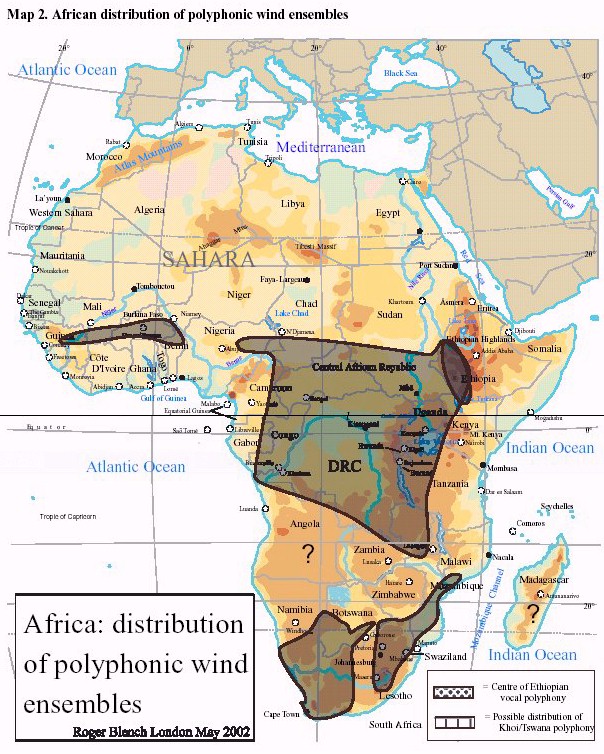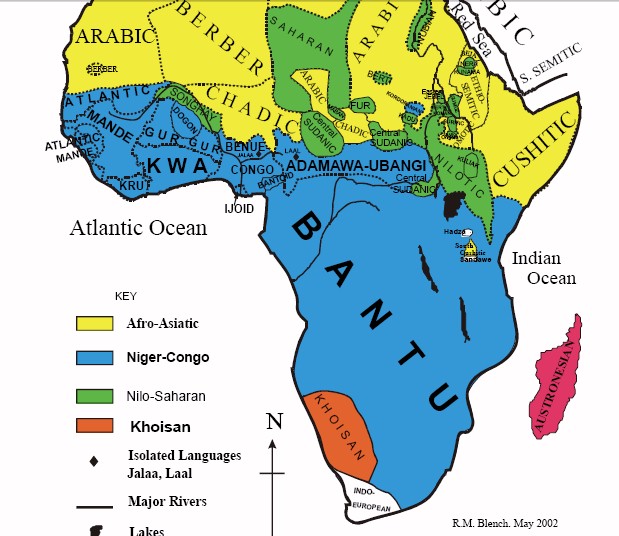I find it interesting that Blench, noted primarily as a linguist, would find a linguistic explanation for the distribution of a musical style family, under the apparent assumption that linguistic and musical families travel together as a unit. (If you notice a trace of sarcasm in the previous sentence, I must immediately clarify, and also apologize, because as a matter of fact Blench's essay pleases me enormously, and I have the greatest respect for what he has both attempted and accomplished therein. He is doing the sort of thing I'm trying to do myself, i.e., seeking out large-scale patterns and attempting to account for them as meaningfully as possible -- and in so doing, challenging some of the most deeply entrenched dogmas of both ethnomusicology and anthropology -- and probably linguistics as well. While I disagree with him over certain points, I admire him enormously for what he has attempted -- and am also very much in his debt, for what he has revealed about this important musical practice, the details of its performance, its social significance, and its distribution.)
To better understand what's at stake, let's take a look at the map Blench presents under the heading, "African Distribution of Polyphonic Wind Ensembles."

He compares this map with the "Outline Map of African Language Families" presented on p. 14 of his essay:
The Nilotic-Saharan language family he associates with the origin of the wind ensembles is in the upper part of the map, represented in green. I'm sorry, but I don't see much of a resemblance between the green portions of this map and the distribution of the wind ensembles as presented on his previous map. As should now be clear, I (respectfully) disagree with Blench. I believe the wind ensembles to be intimately associated with the hocketed vocal styles I've been discussing as possible candidates for humankind's earliest music, practices that would most likely have emerged, according to all the evidence I've been presenting here, among the same ancestral population the geneticists have associated with the origins of both the Pygmies and the Bushmen. I'm grateful to Blench for his distribution map, which looks reasonably accurate, but puzzled as to why he doesn't see the obvious connection with the distribution of both the Pygmies and Bushmen in central and southern Africa, respectively. To make my point rather dramatically, I'd like to present his wind ensemble map side by side with a map I've put together showing the distribution of both these groups. My map is something of a Frankenstein monster, complete with very visible seams, but nevertheless clear, I hope. The ivory colored rectangle is taken from the following Wikipedia article, on Pygmies. If you scroll down about halfway, you'll see a partial map of Africa, entitled "Distribution of Pygmies According to Cavalli-Sforza." This is Luca Cavalli-Sforza, one of the pioneers of genetic anthropology, who has devoted a great deal of attention to the various Pygmy groups over many years. I've superimposed his map over a more complete map of the entire continent, to which I've added two words: "Tellem," to indicate the location of a Pygmy group thought to have once been based in southern Mali, though no longer present in that area today; and "Bushmen," to indicate the general location of the Bushmen, now based in the Kalahari desert area of Botswana and Namibia, but thought to have formerly inhabited the entirety of southern Africa:


To get a clearer view of each map, just click on it and an expanded version will appear. As I see it, this speaks for itself, but you know me -- I've be having a lot more to say, as usual.






No comments:
Post a Comment